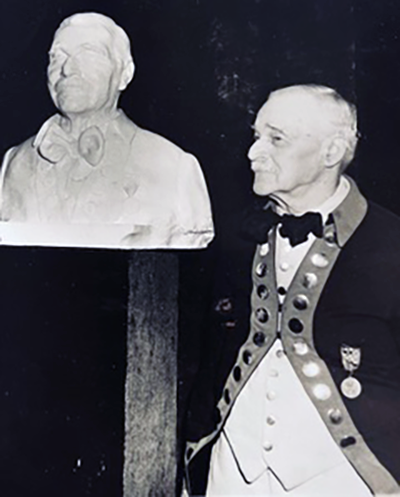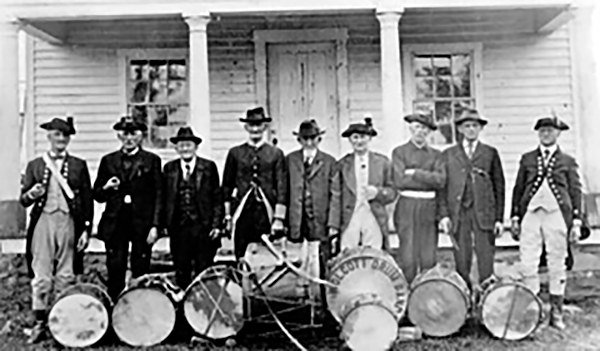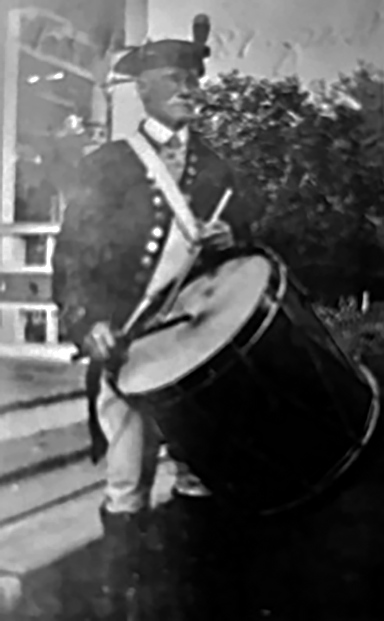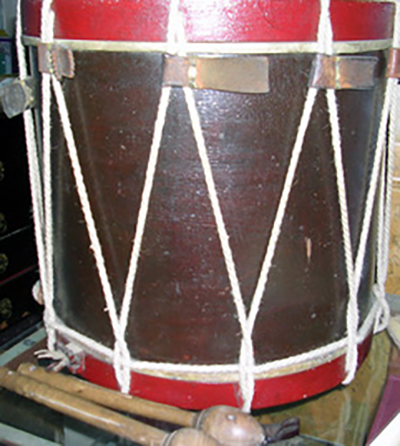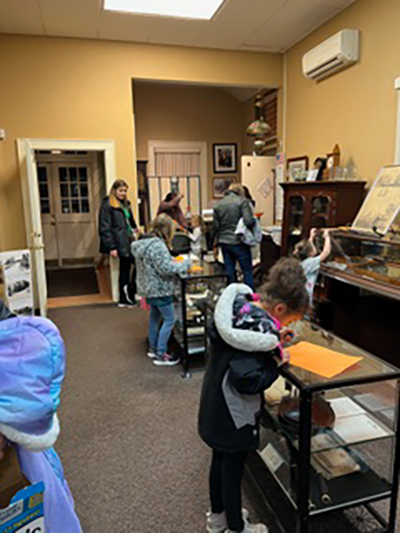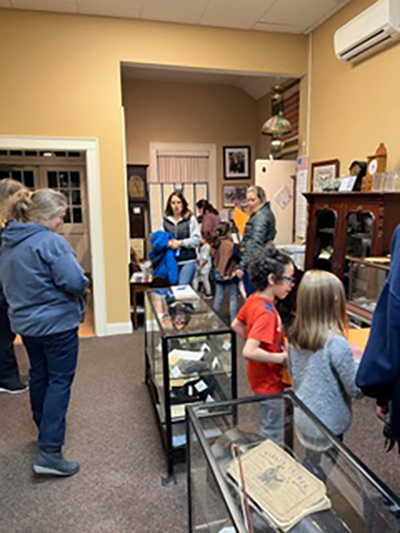|
|
||||||||||||
 |
 |
|
Wolcott Historical Society News - March 2024 By Florence Goodman Early settlers of our town realized it was important to be prepared to protect themselves and their property in times of need. By law, all males ages sixteen to sixty were subject to military duty and required to participate in Training Days, which took place six times a year. In 1767 the newly formed Farmingbury Train Band was founded under the command of Captain Aaron Harrison, Lt. Heman Hall, and Ensign Josiah Rogers. Drummers and the fifers were essential components of the First Militia Company and were skillful in martial music and became known throughout the region for their patriotic sound. In 1775 the trainband Company in Farmingbury consisted of forty-one men. When a National Army was established in 1775 under General George Washington the Farmingbury Company was disbanded. Many Farmingbury men enlisted as drummers and fifers in this newly formed Army; records indicate that at least one hundred Farmingbury men served in various areas of action from Montreal, Canada to Yorktown, Virginia in the Revolutionary War. At the end of the war, two companies of Trainbands were organized and commanded by Captain Heman Hall and Captain Levi Gaylord. Again, the Drum Band, although a separate unit, became an important part of the two companies. On general training days the men were outfitted in bright red coats with brass buttons, buff pants, and plumed hats. Their leader Nathan Gillet was said to be one of the best Fife Majors in the Continental Army. In 1796 when the town was incorporated and took the name of Wolcott, the Drum Band changed its name to the Wolcott Drum Band.
Recently the Historical Society received some very interesting donations. This month, I'd like to share information we received from the estate of Dr. Robert Alan Kraft of Ambler, PA who passed away in September 2023 at the age of 89. Bob was born in Wolcott in 1934 to Howard and Marian (Northrup) Kraft. The Kraft family has strong roots in our town; their heritage is connected to the Pierpont, Hall, Northrop, Frisbie, Somers, and Miller families. Bob's mother, Marian Kraft, grandmother, Margaret Hall and great-grandfather, Charles S. Miller were all historians and saved volumes of our local history; the Historical Society now has the task of organizing and preserving it. Part of that history includes the Mattatuck Drum Band whose early history is found in Farmingbury and Bob's great-grandfather was an important part of that band. The Drum Band has had various names throughout its history. It originated as the Training Band, followed by the 10th Regiment Band, the Farmingbury Band, the Wolcott Drum Band, and since 1881, the Mattatuck Drum Band.
During the War of 1812 recruits were again needed to help fight the war so a recruiting station was set up in the far southern section of Wolcott at Lewis Tavern and another in Waterbury at East Farms. The officers of these companies called upon the Wolcott drummers to "drum up" volunteers for this war effort and they did. In 1830 Samuel Wilcox became the leader of the Drum Band. He introduced a new, original style of drumming based on notation with a full set of rudiments and beats; this became known as the Wilcox Style. The Drum Band became renowned for its fine music and appearance until 1845, but soon after that date the State Militia died out and so did interest in drum bands. The Wolcott Drum Band was not the same; uniforms were lost and worn out, members died, and others moved away. Those that were left turned out at parades, rallies and fairs without uniforms and many instruments were missing.
When the Civil War broke out drummers were scarce, but greatly sought after and again the Wolcott drummers rallied. Early in 1862 Col. H.C. Hart was in Southington recruiting drummers and fifers for the Regimental Drum Band. While staying at a local inn he heard drums in the distance and was told that the Wolcott Drum Band was practicing six miles away in the center of town. He hired a team and hastened to Wolcott. There he hired Mr. Henry Chatfield as leader and instructor and Hezekiah and Leslie Todd as fifers. They were able to recruit other drummers and fifers needed for the 71st Regiment of New York. Later, the 71st Regiment was said to be one of the best Drum Corps in the Army.
When the war ended many of the fifers and drummers found residence elsewhere, thus the Drum Band numbers were few, but they kept the Band going. In 1872 Charles S. Miller joined the Drum Band at the age of fourteen. As a youngster, he lived in Wolcott with his grandmother, Mrs. A. Frisbie Somers, and attended school at the old stone schoolhouse on Nichols Road. By1876 there were only five members left. In the fall of 1877, Mr. Levi Atkins and his son, Homer, reorganized the Band by teaching about sixteen new young men how to fife and drum. They bought new uniforms, which consisted of red shirts, three-cornered hats, blue pants, and white belts. They also had assistance from Elihu Moulthrop as Drum Major, and the hills of Wolcott once again were filled with that wonderful sound. Later, Captain George F. Hotchkiss took over as Drum Major. After several years many of the younger boys lost interest and the older men were tired so in 1881, Charles Miller and several East End Waterbury boys bought the equipment from the old Band and moved it to Waterbury; they renamed it the Mattatuck Drum Band because Mattatuck was the Native American name for Waterbury. Some Wolcott men still belonged to the new band, they were Charles S. Tuttle, Arthur Harrison, Franklin Browne, Robert Wakelee, Frederick C. Moulthrop, Bement Wakelee, Edgar Upson, and Morris Tyler.
Bob Kraft's great-grandfather provided much of the above information about the Mattatuck Drum Band. When Miller moved to the east end of Waterbury, he lived at the corner of East Main Street and Frost Road; this was referred to as Oak Corners. He made many of the drums that were used by the drummers in the Band, and he taught more boys to drum during this period than anyone in Connecticut. Miller kept daily journals throughout his life from 1876 until his death in 1943. His journals continually referred to teaching students how to drum and fife. A portrait bust of Mr. Miller was unveiled on February 15, 1942, on the 175th anniversary of the Mattatuck Drum Corps and Band. It also marked the 50th anniversary of Mr. Miller's direction of the Band. It is obvious that the Mattatuck Drum Band holds a special place in the hearts and history of early Wolcott residents and it's people like the Bob Kraft who saved the photos and journals that have now been returned to us to share with our residents. We also received three of Miller's fifes which are on display at our Center School History Museum. Last month the Brownies from Troop 64126 were able to visit the museum and enjoy some of these artifacts.
(Information for this article was taken from a May 31, 2009 article by Flo Goodman in the Wolcott Community News)
Charles Miller standing next to the bust of himself, February 15, 1942.
Surviving members of the Wolcott Drum Band in front of the old Town Hall in Wolcott Center on October 15, 1922. Left to right: Arthur Harrison, Homer Atkins, Edgar Moulthrop, Linus Norton, Newell Moulthrop, Harley Norton, Frederick C. Moulthrop, Charles S. Tuttle and Charles S. Miller, leader for 40 years in this photo.
Charles Miller in uniform in 1892.
Drum from the Mattatuck Drum Band found in our Center School History Museum.
Brownie Troop visited the Center School History Museum on January 29, 2024.
Brownie Troop visited the Center School History Museum on January 29, 2024.
To view past installments of the Historical Society News, click here. |
|
|
[Home]
[News]
[Purpose]
[Calendar]
[Museum]
[Membership]
[History]
[Contacts]
[Links]
All material at Wolcott Historical Society Web sites Copyright © 2000-2024 Wolcott Historical Society |
